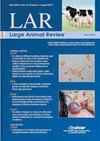Bilateral Convergent Strabismus with Exophthalmos in cattle - what do we know?
IF 0.3
4区 农林科学
Q4 AGRICULTURE, DAIRY & ANIMAL SCIENCE
引用次数: 0
Abstract
The aim of this paper is to describe the most important aspects of the so called "Bilateral Convergent Strabismus with Exophthalmos (BCSE)", the most common aspect of strabismus in cattle. The disease has been known since the end of the XIX century, but no definitive conclusion has been found in respect to the pathogenesis and the etiology. BCSE may affect all major breeds and is known worldwide. It is characterised by a progressive bilateral symmetric anterior- medial rotation of the bulbi associated with a slight to severe protrusion of the eyeball (exophthalmos). The onset of the defect is around the first year of age. It usually ends up with severe visual deficit that might modify the behavior of the affected animal. Although there is few literature, defects in the lateral rectus muscle and the retractor bulbi muscle of the eye and in their appendant nerves (CN III and CN VI, respectively) were suspected to be the cause of BCSE. The presence of "red ragged fibers" in the lateral and median rectus muscles were also found in affected animals. It is common to note changes of character, probably related to insecurity resulting from visual difficulties: the affected animals become scary, move with difficulty, struggling to enter the milking stations, over-react to the routine operations that are carried out in the barn. As to the authors' knowledge, there are no useful therapies to cure or even improve the disease. The majority of the authors consider the BCSE as an inherited defect. However, the exact mode of inheritance has not been found yet. Recent studies carried out on German Brown cattle affected by BCSE showed a significant SNPs association with the disease within two candidate genes located on BTA5 (PLXNC1) and BTA18 (RDH13). Although the role of these genes could not be definitively confirmed, it is most likely that these candidate genes or nearby located structural mutations may be responsible for BCSE in German Brown cows.牛双侧会聚性斜视伴眼球突出-我们知道什么?
本文的目的是描述所谓的“双侧会聚性斜视伴突出眼(BCSE)”的最重要方面,这是牛斜视最常见的方面。这种疾病自19世纪末就已为人所知,但在发病机制和病因学方面尚无明确的结论。疯牛病可能影响所有主要品种,并在世界范围内众所周知。其特征是进行性双侧对称球前内侧旋转伴轻微至严重的眼球突出(突出眼)。这种缺陷在一岁左右出现。它通常会导致严重的视觉缺陷,这可能会改变受影响动物的行为。虽然文献很少,但怀疑眼外侧直肌和牵张球肌及其附属神经(分别为CN III和CN VI)的缺陷是导致BCSE的原因。在患病动物的外侧和正中直肌中也发现了“红色粗糙纤维”的存在。通常会注意到性格的变化,可能与视觉障碍造成的不安全感有关:受影响的动物变得可怕,行动困难,挣扎着进入挤奶站,对在谷仓进行的日常操作反应过度。据作者所知,目前还没有有效的治疗方法来治愈甚至改善这种疾病。大多数作者认为BCSE是一种遗传缺陷。然而,确切的继承方式尚未发现。最近对受BCSE影响的德国棕色牛进行的研究表明,位于BTA5 (PLXNC1)和BTA18 (RDH13)上的两个候选基因与该疾病存在显著的单核苷酸多态性关联。虽然这些基因的作用还不能确定,但很可能是这些候选基因或附近的结构突变导致了德国棕色牛的BCSE。
本文章由计算机程序翻译,如有差异,请以英文原文为准。
求助全文
约1分钟内获得全文
求助全文
来源期刊

Large Animal Review
AGRICULTURE, DAIRY & ANIMAL SCIENCE-
CiteScore
0.90
自引率
16.70%
发文量
0
审稿时长
>12 weeks
期刊介绍:
Large Animal Review is a bimonthly magazine published by
SIVAR (Italian Society of Farm Animals Veterinary Practitioners) for
scientific updating of veterinarians who deal with animals in livestock production and the supply chain control in the production
of food industry. The topics of main interest for the journal are
those of internal medicine, surgery, obstetrics, animal nutrition,
zootechnics, infectious and parasitic diseases, food safety and security, animal welfare, prevention and management.
 求助内容:
求助内容: 应助结果提醒方式:
应助结果提醒方式:


